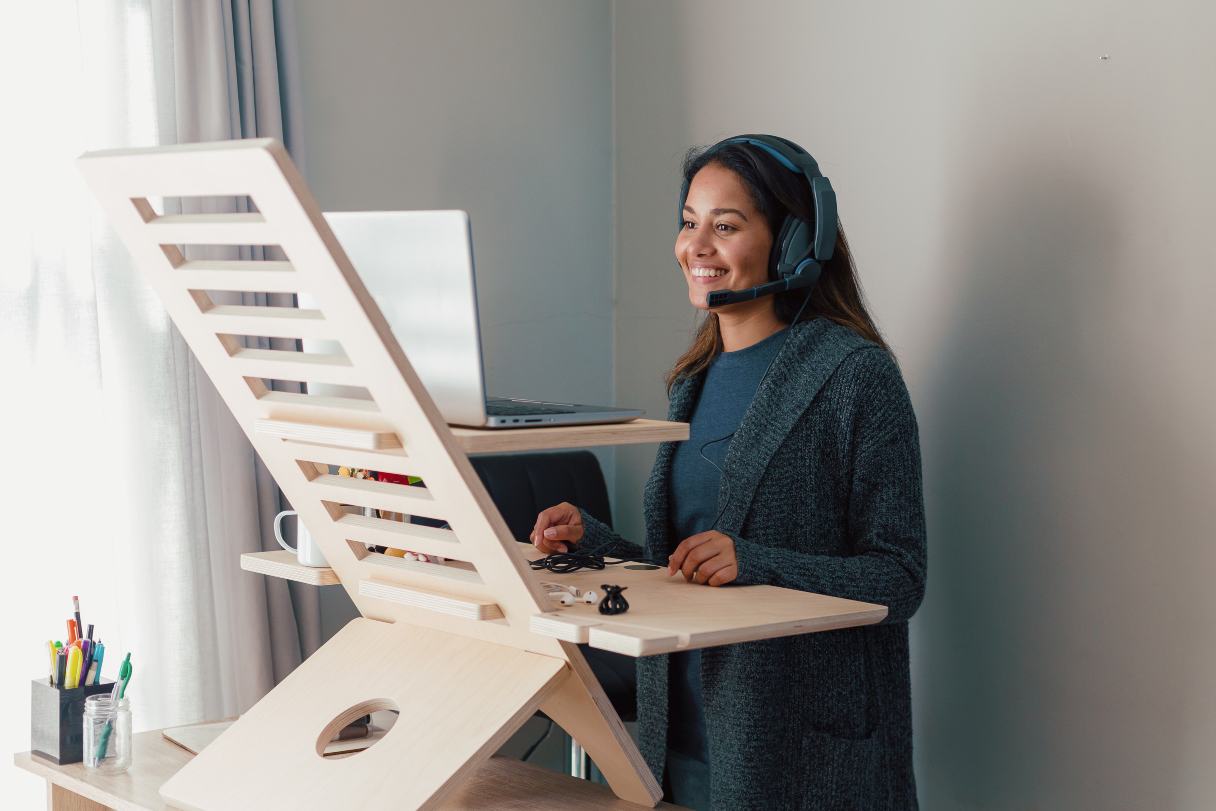Raise your hand if you spend hours a day working in front of a computer, scrolling on your cell phone or sitting behind the wheel of a car? If so, you probably already have seen how these sedentary habits can impact your posture.
Good posture is characterized by the proper alignment of the body and adequate muscle strength to reduce excess strain on muscles, joints and ligaments.1
There are two kinds of posture: static and dynamic.2
- Static posture is how you hold your body when you are stationary, such as sleeping, sitting or standing.
- Dynamic posture is how you hold your body when you are in motion, such as walking, running or bending.
While “Sit up straight!” and “Don’t slouch!” may be common childhood messages for kids, most adults today may want to consider them as well. Improving your posture while you sit, stand, scroll, drive and even sleep can have long-lasting benefits for your body from head to toe. Try these tips to begin improving your posture today.
1. Be Mindful of Your Posture
It might sound simplistic, but being more aware of your posture during your everyday activities can bring about noticeable improvements.2 Whether you’re carrying grocery bags, lifting boxes in the garage or scrolling on your phone, being mindful of how you are holding, supporting and moving your body can help you make small tweaks to improve your posture and prevent injury.3
2. Stay Active
Regular physical activity, including strengthening and stretching, helps avoid tension, fatigue and strain on your tendons, ligaments and muscles, which supports good posture.4 Exercises that emphasize body awareness, such as tai chi and yoga, can be especially beneficial for improving posture.2
3. Strengthen Your Core
Strengthening your core can also help ensure the muscles supporting your back, pelvis and stomach are strong.2 Exercises such as side planks and bridges can help build abdominal strength for improved posture support.5
4. Maintain a Healthy Weight
Carrying excess weight around your midsection can weaken or strain muscles that support your back, pelvis and spine, negatively impacting your posture.2 Maintaining a healthy weight can help ensure your muscles and joints aren’t overly strained.5
5. Find a Firm Foot Foundation
When standing, the American Chiropractic Association recommends keeping your feet shoulder-width apart, with your body weight primarily on the balls of your feet.1 This alignment can help provide a solid foundation to support the rest of your body.
6. Move Your Shoulders Back and Down
Being hunched over a computer all day with poor desk posture can overextend back muscles and shorten pectoral muscles, causing the shoulders to collapse forward. A good posture goal is to strengthen and stretch the muscles in the upper back, chest and core.6
7. Try Chin Tucks
Want to relieve neck pain? Performing exercises that bring your head back into a neutral position is key. While sitting in a chair, look straight ahead and glide your chin straight back. Being mindful about proper posture can help prevent debilitating neck pain and keep your spine in good shape.7
8. Select Posture-Friendly Footwear
Your footwear can have an impact on your posture as well. While sky-high heels might be in vogue, they can wreak havoc on your posture. Shoes with a high heel cause your back to overarch and increase pressure on your knees and back. Save heels for special occasions, and instead opt for low-heeled shoes for your day-to-day look.3
9. Evaluate Your Desk Ergonomics
If you spend all day at a desk or on a computer, the arrangement and height of your desk, computer and chair can play a big role in your daily posture. Evaluate your work environment to ensure your computer is at eye level, your feet rest on the floor and your knees and elbows are bent at roughly 90 degrees.5
10. Switch up Your Stance
If you sit for long periods during your day, break up the day by taking walks and changing positions to give your body variety. Stretching helps ease muscle tension. Then, each time you sit again, be mindful of avoiding unbalanced postures.8
11. Support Your Lumbar
Whether sitting at your desk, your car or your couch, ensure your lower and mid-back have adequate support. Lumbar support helps reinforce the small of your back and prevents slouching. Look for ergonomic desk chairs, lumbar support pillows or even use a rolled-up towel.8
12. Adjust Your Eye Level
The so-called “tech neck” is real — and it’s bad for your posture.7 Staring down at a phone or laptop screen for hours each day can lead to neck pain and headaches.6 For computer and smartphone use, make sure the top of your monitor is at or just below your eye level to avoid craning your neck upwards or downwards for extended periods.7
13. Practice Postural Exercises and Routines
Stretching is a simple way to help support better posture. Focus on including specific movements like the cat-cow stretch to mobilize your spine and chest stretches to counteract slouching. Incorporating these kinds of stretches into your routine can improve flexibility, build the muscles that support your spine and offset the effects of prolonged sitting.3
14. Train Your Breathing
Good posture and a healthy respiratory system work hand in hand. Slouching can strain the respiratory system by limiting the movement of the diaphragm and decreasing your lung capacity. Focusing on deep, diaphragmatic breathing can encourage better spine alignment and core engagement.9
15. Take Advantage of Digital Posture Reminders
It can be tricky to regularly remember to prioritize good posture, so take a little help from technology. Set alarms or use wearable fitness devices to remind you to stretch, check your posture or get up and move at regular intervals.3
16. Get Your Eyes Checked
Many people become nearsighted as they get older. However, decreased vision can cause you to move your head closer to a phone, book or newspaper to read. Have an optometrist check your vision annually and consider reading glasses or contact lenses to support your reading.10
17. Check Your Driving Posture
It’s important to maintain good posture while driving, too, especially if you spend extended time periods in the car. Consider using a portable lumbar support if needed to provide back support while in the car.8
18. Don’t Ignore Your Hips and Pelvis
The natural resting position of your hips and pelvis can also contribute to your overall posture. Anterior pelvic tilt and one-sided hip elevation can contribute to poor posture. Exercises that stretch and strengthen the gluteal muscles, hip flexors, and supporting muscle groups can help improve pelvic stability.11
19. Assess Your Sleep Position
Don’t sleep on getting good posture! How your body is positioned while you sleep may affect your daytime posture, too. Avoid your stomach if possible and try to sleep on your back or side with a pillow that supports your neck’s natural curve and one between your knees if you’re on your side.1
20. Hydrate for Healthy Connective Tissue
Dehydration can lead to stiffer muscles and connective tissues. Staying hydrated supports joint and tissue health, which is beneficial for posture.5
21. Be Mindful of Balancing Your Load
If you regularly carry a briefcase, backpack or purse, assess the weight of it and how you are carrying it. Regularly carrying excess weight on one side can create uneven pressure on the spine. When carrying anything heavy, try to balance the weight between both sides of your body, rather than relying on one side.12
22. Seek Professional Guidance if Needed
If you’re struggling to improve your posture on your own or are navigating other health or physical conditions, consider consulting a physical therapist, chiropractor or posture specialist who can provide assessment and personalized guidance and help personalize a treatment plan for your needs.
Why Posture Matters
Maintaining good posture can be important for several reasons, including:
- Allowing for the optimal functioning of bodily systems, including the respiratory, circulatory and digestive systems3
- Contributing to an overall appearance of confidence, poise and well-being5
- Helping to distribute the forces of gravity evenly through the body, reducing stress and wear on specific muscles and joints1
- Helping to support balance and reduce the risk of falling2
- Maintaining flexibility and reducing the risk of discomfort associated with poor posture5
Poor posture, such as slouching or prolonged periods of sitting in a hunched position, could potentially lead to muscle imbalances, pain and potential long-term health issues.
Improve Posture to Help Improve Your Health
Improving your posture doesn’t have to involve complicated medical procedures or time-intensive workouts. There are simple steps you can take throughout the day that can offer long-term benefits to your sitting and standing posture.
Managing Health and Wellness Costs With the CareCredit Credit Card
If you are looking for an option to help manage your health and wellness costs, consider financing with the CareCredit credit card. The CareCredit credit card can help you pay for the care you want and need and make payments easy to manage.* Use our Acceptance Locator to find a provider near you that accepts CareCredit. Continue your wellness journey by downloading the CareCredit Mobile App to manage your account, find a provider on the go and easily access the Well U blog for more great articles, podcasts and videos.
Your CareCredit credit card can be used in so many ways within the CareCredit network including vision, dentistry, cosmetic, pet care, hearing, health systems, dermatology, pharmacy purchases and spa treatments. How will you invest in your health and wellness next?
Author Bio
Kate Bayless is a health and wellness freelance writer with 15 years of experience. Her work has appeared in Parents, Women’s Health, Beachbody and OpenFit.







